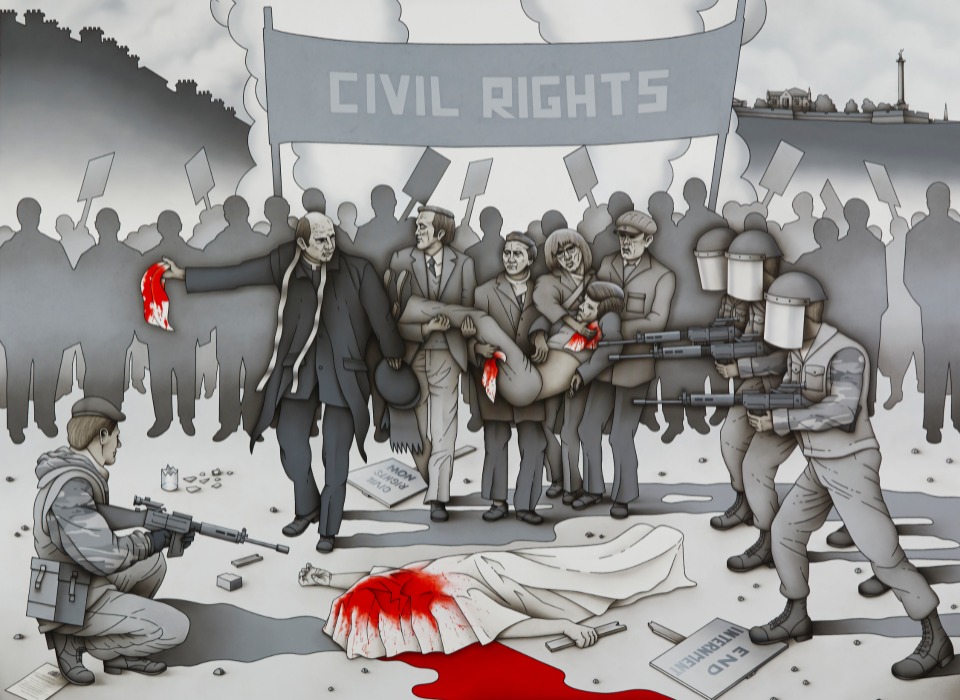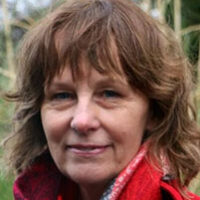
When Robert Ballagh, the outstanding contemporary Irish painter, found a growing need to make a statement on the 50th anniversary of Bloody Sunday, he felt more and more drawn to paintings that had impacted him in the past. The most compelling one in relation to the Derry massacre was Goya’s The Third of May, a painting depicting the execution of Spanish people on Spanish soil by the invading French army. Ballagh’s painting is entitled The Thirtieth of January. The parallels in the situation are clear: On Bloody Sunday, Irish people were executed on Irish soil, by British soldiers.
What happened in Derry on the 30th of January 1972?
Bloody Sunday was a turning point in the North of Ireland conflict. It broke the civil rights movement, which in the late 1960s had placed an international spotlight on the sectarian, Unionist regime’s repressive measures against peaceful demonstrators demanding equal rights for Catholics.
On August 13, 1969, the British Labour government had brought British troops onto the streets, initially to stop sectarian gangs, aided and abetted by the police, attacking nationalist communities in Nazi-like pogroms.
However, when in June 1970 the Tories came to power with Edward Heath as Prime Minister, the British state took on a menacing role. The Tories (the Conservative and Unionist Party) were allies of the N. I. Unionist Party that had controlled the sectarian state since its establishment in 1921. This led to a surge in repression of the Catholic community, culminating in internment without trial in August 1971.
During the introduction of internment, the First Battalion of the Parachute Regiment (1Para) shot dead ten residents, including a mother and a priest, in the Ballymurphy Massacre. A plan drawn up in London by the highest government circles aimed at crushing resistance through acts of “collective punishment” of the Catholic community in the North of Ireland.
A civil rights demonstration was called for Derry on the 30th of January 1972, which demanded an end to internment. The agreement between the chief constable in Derry and the Northern Ireland Civil Rights organization (NICRA) had been that the peaceful march would stay within a Catholic area. The IRA (Irish Republican Army) had also made clear there would be no armed presence on the day.
Increasingly, the British Tories and their Unionist allies had been incensed by the existence of “Free Derry,” a Catholic residential area of the city that had become a “no-go area” for the British security forces since the pogroms of August 1969. It was here that the civil rights demonstration was set to take place. An attack on such a demonstration, it was later claimed, was expected to lead to a direct confrontation between the shock-troops of 1Para and the IRA and result in “Free Derry” being subjugated. If this plan failed to materialize then the demonstrators, who were deemed by the British high command to be part of the enemy, could be taught a lesson.
And so the massacre in Derry was planned by Heath and high-ranking military. A 16-soldier-strong company of 1Para was responsible for all the shootings on the day. It included the same soldiers who had been blooded and commended for the Ballymurphy Massacre.
A number of inquiries into Bloody Sunday followed, none of which led to a conviction of those responsible. Although the evidence against the military was overwhelming, only one paratrooper, “Soldier F,” was charged (49 years later!) with the murder of two of the fourteen dead on Bloody Sunday, and then the charges were dropped. The same “Soldier F” had received a commendation for his role in the Ballymurphy Massacre. Currently, the British government is pushing through an amnesty for all those guilty of murder in the North of Ireland in an attempt to stop once and for all the possible prosecution of their military and associated killer squads.
Artists respond
This inability of the British judiciary to deliver justice in such blatant cases has acted as a weeping wound in Ireland. Several of Ireland’s best artists have taken a stand in their work, including Thomas Kinsella, Brian Friel, and Robert Ballagh.
The title of Robert Ballagh’s painting, The Thirtieth of January, makes clear in itself the connection to Goya’s The Third of May. As one might expect, the visual language is compelling. While in Goya’s picture the outline of Madrid sets the location of the executions in 1808, in Ballagh’s it is the Derry skyline, its walls, St Columb’s Cathedral, the Presbyterian church, and indeed with Walker’s Monument still in place. (This was blown up in 1973.) Where there is a hillside behind the Spanish victims on the left of Goya’s picture, in Ballagh’s, the eye moves upward from the Bogside to working-class terraces.

In both paintings, the focus is on the victims, the people against whom, and on whose territory the atrocity is being committed. They are the figures whose faces we see; the soldiers are faceless. While Goya chooses the moment of execution of the central rebel (others already lie dead beside him), Ballagh depicts a scene directly after the shooting has started. He shows us two victims, one dying, the other dead. Looking at the picture, we are faced with a group of distressed people running toward us, a press image that went around the world. The priest, Father Daly, is holding up a white blood-stained handkerchief, trying to shield a group carrying the first victim of the massacre, the mortally wounded Jackie Duddy, out of range. These people are clearly recognizable. They also hold white bloody handkerchiefs, underlining a peaceful protest crushed in blood. In Goya’s painting, too, a monk is by the side of the rebel, offering support, along with others. In addition to this, a priest, Fr. Hugh Mullan, had been shot dead in the Ballymurphy Massacre. So there are many layers of associations in this figure.
Centered in the foreground is another victim, covered in white bloodstained cloth, echoing the handkerchiefs. The stark white, associated with peace, innocence, and martyrdom, reminds viewers of the brilliant white shirt of the man about to be executed in Goya’s painting. He is flanked on the right by a group of faceless soldiers, their weapons by the hip indicating indiscriminate shooting, not taking aim. Another soldier on the left in a kneeling position closer to the body suggests “Soldier F,” who knelt to shoot dead Barney McGuigan as he waved a white handkerchief high above his head, trying to go to the aid of the dying Patrick Doherty. “Soldier F” was responsible for a number of the cold-blooded killings, and the only soldier to be accused of murder, only to be cleared later. Perhaps because of this identity, we see his face in part.
Ballagh makes clear that the marchers were unarmed. We see two placards on the ground reading “Civil Rights Now” and “End Internment.” A Civil Rights banner occupies the upper center of the picture, like a title.
The painting not only references Goya but also Picasso’s Guernica, itself a picture about foreign invaders murdering a native population and inspired by Goya. Like Picasso, Ballagh decided on a monochrome painting. The covered dead man’s hand in the center foreground still holds the broken end of the “End Internment” placard in his right hand, in much the same way as the slain man in Picasso’s painting grasps the broken sword. The left hand also echoes Picasso’s in its reach towards the left corner of the painting, as well as in its gesture. Picasso and Ballagh’s black-and-white execution evokes newspaper images; in Ballagh’s case, most of the press photographs and footage from the event were in black and white. The only color is the blood-red splashes on white. The smoke behind the silhouetted demonstrators in the background suggests the use of tear gas seen in so many photographs of police attacks on demonstrators.
In the left corner, under the foot of the kneeling soldier, we see a sheet of paper with the Royal Coat of Arms and writing on it. They are the words of Major General Robert Ford. The title is the massacre’s military code name, Operation Forecast, and is dated January 30, 1972. The text reads: “I am coming to the conclusion that the minimum force necessary to achieve a restoration of law and order is to shoot selected ringleaders amongst the Derry Young Hooligans.” Ballagh leaves no doubt but that the killings were ordered at the highest level. In this respect, too, the painting goes further than any Inquiry has ever done. Michael Jackson, a senior officer in command, was later promoted to Commander-in-Chief of the British Land Forces.
Art history and political history are connected. Art doesn’t exist outside of time, and there is a tradition in art that does not shrink away from taking sides. Neither does this diminish the artist—think of composer Mikis Theodorakis or poet Pablo Neruda—and of course, Goya’s The Third of May is one such work that has echoed through time. This painting inspired Picasso’s 1937 Guernica and the 1951 Massacre in Korea; it has also been an enduring influence on Robert Ballagh’s work.
The power of this work, through Ballagh’s interpretation, was picked up by a community art group in Derry who recently asked his permission to reproduce his painting after Goya on a wall in Glenfada Park, one of the murder sites on Bloody Sunday. They did this because they could see the direct connection between the terror and the anger of their own experience and that depicted in The Third of May. In both pictures, the viewer is a direct witness to the events and, standing alongside the artist in the midst of this slaughter, feels involved.
Beside it, up until recently, the group had displayed their copy of Picasso’s Guernica. When artists take the side of the people against oppression, they resonate and are understood worldwide because the condition of the victims of wars for profit, power, and control is global. Bloody Sunday is a part of the world history of colonialism, occupation, and people’s resistance, and Robert Ballagh’s painting says just this and demonstrates the necessity of art.










